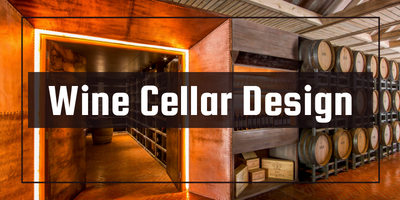
5 Signs Your Wine Cooling System Is About to Fail
Don’t wait for a costly surprise. Wine Guardian Dealer breaks down the top 5 signs your wine cooling system may be failing — and how to fix it before damage...
Jim Hopper
In Stock & Ready to Ship – Order Your Wine Cooling System Today!
Free Wine Cellar Expert Consultation | 📞 Call 1-800-260-1712
Start with a free expert consult—cooling system sizing, racking options, and no upsells.

Build your dream wine cellar—without costly mistakes or guesswork.
By Jim Hopper, Wine Cooling Expert
Building the perfect wine cellar is a rewarding project that enhances your home and preserves your wine collection for years to come. A controlled environment is crucial in wine cellars, requiring specialized equipment and construction elements to regulate temperature and humidity.
Whether you’re an avid collector or a casual enthusiast, understanding the basics of wine storage and choosing the right wine cooling system is essential to creating a functional, stylish wine cellar. This guide covers all the key aspects of wine cellar construction, including design, temperature control, and wine cellar accessories.
For a complete walkthrough on creating a high-performance, beautifully designed cellar, explore our full Wine Cellar Design and Installation: Build a Beautiful, Functional Wine Room That Lasts.
In recent years, wine cellars have become a popular feature in many homes. They aren’t just for luxury estates anymore—homewine cellars are a growing trend in modern homes. Whether it’s a small wine cellar in a basement, a custom wine closet, or a large, purpose-built room, a well-designed wine cellar is an investment that adds value to your home. Building a wine cellar can be a fun and exciting project for wine enthusiasts.
In this guide, you’ll learn how to build a wine cellar, select the right wine storage solutions, and design a cellar that suits your space and lifestyle.

Proper wine storage is crucial for preserving the quality of your wine. The ideal wine cellar temperature is 55°F (13°C), while humidity should be kept at 60-70%. These conditions help preserve the cork and prevent oxidation. A well-chosen cooling system can ease the process of maintaining these optimal conditions.
Wine is a delicate product that can easily be damaged by improper storage. Storing your wine in optimal conditions ensures it will age beautifully, enhancing its flavor and value.
Avoid storing wine in fluctuating temperatures, near heat sources, or in direct sunlight. These factors can negatively impact the aging process and overall quality of the wine.
When designing your wine cellar, consider the available space in your home. It is also important to accommodate various bottle shapes when designing wine racks. Whether you’re building a small wine cellar in a closet or a larger, custom wine room, the space you have will impact your wine rack design and overall cellar layout.
Select the right layout and storage capacity based on your collection. A small wine cellar can store around 100-300 bottles, while larger spaces can accommodate 500-1,000 bottles or more.
Before embarking on your wine cellar project, it’s crucial to ensure you have all the necessary permits from your local authorities. This step is essential to guarantee that your wine cellar complies with local, state, and national building codes. Typically, permits are required for any project involving electrical, plumbing, or HVAC work.
To navigate the permit process smoothly, follow these steps:
Remember, it’s always better to err on the side of caution and check with your local authorities before starting your project. This proactive approach will help you avoid any potential issues and ensure your wine cellar is built to code.

Wine rack design is one of the most critical aspects of your cellar. Choose from wooden racks, metal wine racks, or even glass shelves for a modern look. Ensure that the racks hold the wine bottles on their sides so they are properly stored at an angle to keep the corks moist and prevent air exposure.
Wine cellar lighting should be low-heat and UV-free to protect your wine from degradation. Use LED lights that are energy-efficient and provide ample lighting without the risk of UV damage.
Your wine cellar design should match your personal style. Choose between modern, rustic, or even glass-walled designs to showcase your collection in an attractive, functional way.
Creating a tasting area within your wine cellar can significantly enhance your wine-tasting experience. This dedicated space not only provides a comfortable spot to savor your wine but also adds a touch of elegance to your cellar’s decor.
When designing your tasting area, consider the following tips:
Remember, the tasting area is a space where you can relax and enjoy your wine, so design it with both comfort and style in mind. This thoughtful approach will make your wine cellar a happy place to unwind and savor your favorite vintages.
Proper insulation helps maintain a stable environment inside your wine cellar, ensuring that the temperature and humidity stay consistent. Vapor barriers prevent moisture from seeping into the cellar, protecting your wine from potential damage. Additionally, it is crucial to make the wine cellar safe from intruders and theft by implementing security measures like locks and surveillance systems.
The most important feature of a wine cellar is its cooling system. Choose a system that maintains a consistent temperature and humidity level suitable for wine storage. Popular options include ducted cooling systems, through-the-wall wine coolers, and split systems.

Wine cooling systems are available in several types:
When selecting a wine cooling unit, consider the size of your cellar and the climate in your area. Energy efficiency and cooling capacity are crucial factors for maintaining the right conditions for wine storage.
Building a wine cellar requires meticulous planning and attention to detail. Here are some key considerations to keep in mind to ensure your cellar is both functional and aesthetically pleasing.
Furring and framing are foundational steps in constructing a wine cellar. Furring involves installing strips of wood to raise surfaces or prevent dampness, while framing involves building the walls and ceiling.
When furring and framing your wine cellar, consider these guidelines:
Electrical outlets and wiring are critical components of your wine cellar’s infrastructure. Here are some key considerations to keep in mind:
Remember, a well-designed and well-built wine cellar is essential for storing and enjoying your wine collection. By following these tips and guidelines, you can create a beautiful and functional space that will provide years of enjoyment.

In addition to racks and cooling systems, wine cellar accessories enhance the functionality and aesthetics of your space:
If you live in a climate with extreme heat or cold, installing the right wine cooling system is even more important. Proper insulation and humidity control can mitigate the effects of a harsh environment on your wine collection.
Building a wine cellar yourself can be a cost-effective option, especially for smaller spaces. A DIY project requires careful planning, especially when it comes to wine rack design, cooling systems, and insulation.
For larger, custom wine cellars, hiring a professional can help you achieve the perfect design, installation, and cooling system integration. Professional installers ensure everything runs smoothly and meets wine cellar requirements.
Routine maintenance of your wine cellar includes checking the wine cooling systems, cleaning racks, and monitoring humidity levels . Keeping your cellar in optimal condition will protect your wine investment for years to come.

Explore stunning examples of luxury wine cellars that range from minimalist modern designs to rustic, wooden spaces. Get inspiration for your own custom wine cellar with our wine cellar design ideas.
The space required depends on your collection size. A small wine cellar stores 100-300 bottles, while a larger wine cellar can hold up to 1,000 bottles or more.
Wine cellar construction costs range from $1,500 for small DIY projects to $50,000 for custom-built wine rooms with high-end features.
Yes, you can add a wine cellar to your existing home, whether it’s a basement wine cellar or a closet wine cellar. Custom designs make it easy to convert existing spaces.
The best wine cooling systems include through-the-wall wine coolers, ducted cooling systems, and split systems, depending on your cellar size and needs.
Use a wine cooling system with humidity control to maintain a consistent temperature of 55°F (13°C) and 60-70% humidity.
🛒Shop our most-loved Wine Guardian cooling systems today.
🛠️Protect your wine with the most trusted systems on the market.
❤️Tested, reviewed, and loved by serious collectors like you.